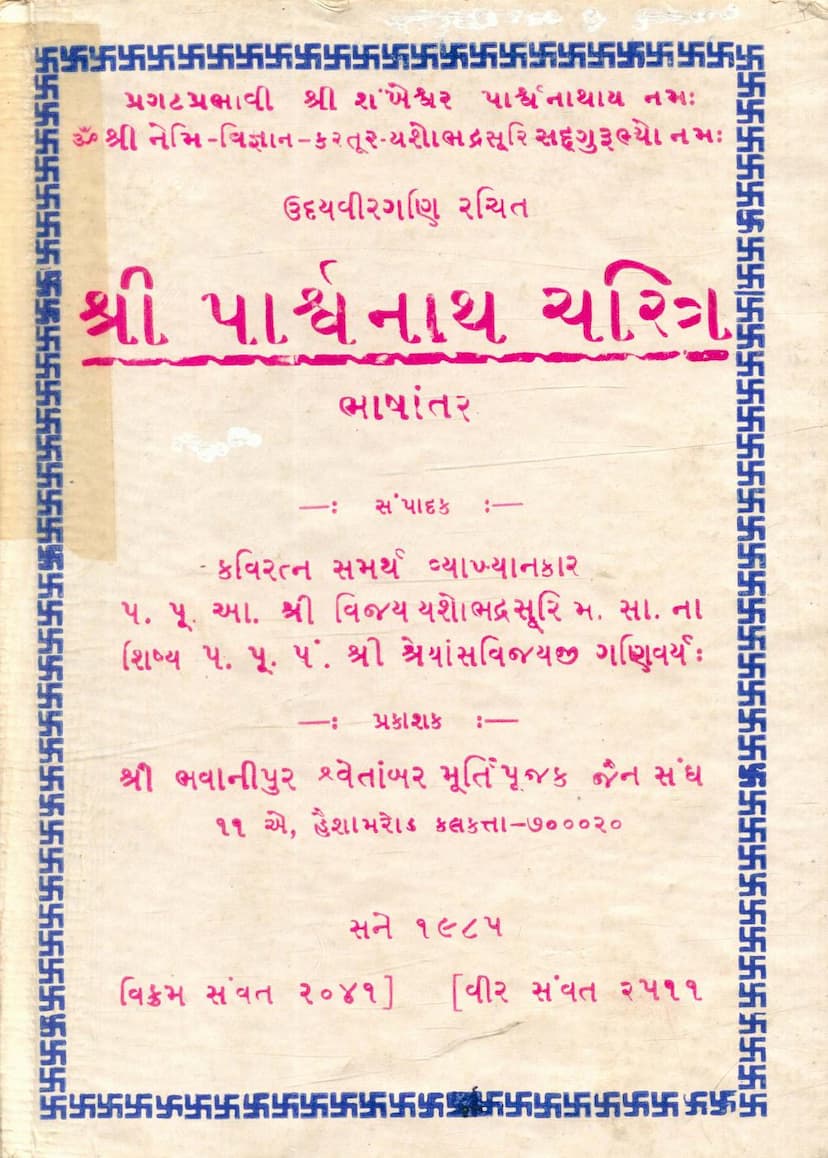Parshwanath Charitra
Added to library: September 2, 2025

Summary
Based on the provided text, here is a comprehensive summary of the "Parshwanath Charitra" by Udayvirgani, translated and edited by Shreyansvijayji:
Book Title: Parshwanath Charitra Author(s): Udayvirgani, Shreyansvijay Publisher: Shri Bhavanipur Shwetamber Murtipujak Jain Sangh, Kolkata Year of Publication: 1985 (Vikram Samvat 2041, Veer Samvat 2511)
Overall Summary:
The "Parshwanath Charitra" is a Jain text that chronicles the life story of Lord Parshvanath, the 23rd Tirthankara, through his various incarnations (bhavs) across multiple lifetimes. The narrative highlights the soul's journey towards liberation by illustrating the profound impact of actions (karma) and the importance of spiritual discipline, ethical conduct, and devotion. The text is structured into eight chapters (sargs), detailing Lord Parshvanath's past lives and the ultimate path he took to achieve Keval Gyan (omniscience) and Moksha (liberation).
Key Themes and Content:
- The Journey of the Soul: The primary focus is on the transmigration of the soul, particularly the life force (jiv) that eventually incarnates as Lord Parshvanath. Each life demonstrates the consequences of virtues and vices, the unfolding of karma, and the gradual purification of the soul.
- Ethical Principles: The text emphasizes Jain ethical principles such as Ahimsa (non-violence), Satya (truthfulness), Asteya (non-stealing), Brahmacharya (celibacy/chastity), and Aparigraha (non-possession). These principles are illustrated through the exemplary lives and the teachings of the characters.
- The Nature of Karma: The narrative repeatedly shows how past actions (karma) influence present circumstances and future lives, underscoring the principle of cause and effect. The suffering of characters like Kamat is a direct result of their negative actions.
- The Path to Liberation: The text highlights the arduous but ultimately rewarding journey towards spiritual liberation (Moksha). This involves renunciation, austerities (tapas), devotion, and the cultivation of right faith (samyaktva), right knowledge (samyakgyan), and right conduct (samyakcharitra).
- Illustrative Narratives: The "Parshwanath Charitra" is rich with various illustrative stories and anecdotes, often presented as teachings from monks, spiritual guides, or the Tirthankaras themselves. These stories serve to clarify complex spiritual concepts and inspire the readers.
- Lord Parshvanath's Life: The latter part of the text specifically details the birth, youth, renunciation, spiritual practices, omniscience, preaching, and final liberation of Lord Parshvanath. It also describes the divine arrangements and celestial events associated with his life, such as the Samavasharan (divine assembly) and the worship by celestial beings.
- Devotion and Practice: The importance of sincere devotion (bhakti) through various forms of worship, such as Pushpa Puja (flower worship), Akshat Puja (rice worship), and Bhava Puja (internal devotion), is consistently emphasized.
- Cycles of Birth and Death: The text portrays the cyclical nature of birth, death, and rebirth, showing how the soul evolves through different states of existence based on its karma.
Summary of the Chapters (Sargs):
The text is divided into eight chapters, summarizing significant lives and events:
- First Sarg (Bhav 1-3): Covers the initial lives of the soul, featuring characters like King Aravind, Queen Dharini, Purohit Vibhuti, Marubhuti, and Kamat. It details events leading to renunciation, karma's consequences (like rebirth as an elephant and a serpent), and eventual spiritual progress.
- Second Sarg (Bhav 4-5): Narrates the lives of Kiranveg and Dhandar, highlighting the impact of ethical conduct, the consequences of negative associations, and the attainment of celestial realms.
- Third Sarg (Bhav 6-7): Focuses on the lives of Vanabh, Kubera, and the merchant sons, emphasizing the importance of right conduct, the rejection of atheism, the nature of karma, and the benefits of righteous association.
- Fourth Sarg (Bhav 8-9): Details the lives of Suvarnabahu and the subsequent king, illustrating themes of renunciation, divine intervention, spiritual realization, and the eventual attainment of omniscience and liberation.
- Fifth Sarg (Bhav 10 - Final): Describes the progression of the soul, including its journey through hellish realms and further rebirths, ultimately leading to the final incarnation and eventual liberation. The story of Lalitang Kumar and his encounters with virtue and vice is a significant part of this chapter.
- Sixth Sarg: This chapter continues the narrative, detailing the lives of various characters and their spiritual journeys, including the stories of Dhanmitra (importance of Gyan Daan - knowledge donation), Vasatak (Abhay Daan - fearlessness donation), and others, all reinforcing the teachings of Dharma.
- Seventh Sarg: Focuses on the core principles of Jainism, including the explanation of the twelve vows, the importance of Jin Pooja (worship of Jain Tirthankaras), and the various types of worship. It also delves into the strictures of adherence to Jain principles.
- Eighth Sarg: This chapter describes Lord Parshvanath's arrival in Saketpur, his interactions with Sagaradatta, the establishment of the Jain Dharma, and his eventual journey to Mount Samet Shikhar for his final liberation. It also includes the story of Bandhudatta and the eventual attainment of Moksha by all involved.
Publisher and Editors:
The book is published by Shri Bhavanipur Shwetamber Murtipujak Jain Sangh in Kolkata. The translation and editing are attributed to Pt. Shreyansvijayji Ganivarya, a disciple of the revered Acharya Shri Vijay Yashobhadrasuri Maharaj Saheb, known for his scholarly contributions and spiritual guidance.
Significance:
The "Parshwanath Charitra" serves as a significant text for Jain followers, offering a detailed account of the life and teachings of Lord Parshvanath. It aims to inspire readers by demonstrating the spiritual path and the ultimate goal of liberation, reinforcing the values of righteousness, compassion, and self-discipline. The text is considered a valuable resource for Jain education and spiritual understanding.